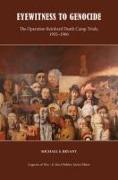- Start
- Eyewitness to Genocide: The Operation Reinhard Death Camp Trials, 1955-1966
Eyewitness to Genocide: The Operation Reinhard Death Camp Trials, 1955-1966
Angebote / Angebote:
One of the deadliest phases of the Holocaust, the Nazi regime's "Operation Reinhard"produced three major death camps--Belzec, Treblinka, and Sobibor--which claimed thelives of 1.8 million Jews. In the 1960s, a small measure of justice came for those victimswhen a score of defendants who had been officers and guards at the camps were convictedof war crimes in West German courts. The conviction rates varied, however. While all butone of fourteen Treblinka defendants were convicted, half of the twelve Sobibor defendantsescaped punishment, and only one of eight Belzec defendants was convicted. Also, despite the enormity of the crimes, the sentences were light in many cases, amounting to>In this meticulous history of the Operation Reinhard trials, Michael S. Bryant examinesa disturbing question: Did compromised jurists engineer acquittals or lenient punishmentsfor proven killers? Drawing on rarely studied archival sources, Bryant concludesthat the trial judges acted in good faith within the bounds of West German law. The keyto successful prosecutions was eyewitness testimony. At Belzec, the near-total efficiencyof the Nazi death machine meant that only one survivor could be found to testify. At Treblinkaand Sobibor, however, prisoner revolts had resulted in a number of survivors whocould give firsthand accounts of specific atrocities and identify participants. The courts, Bryant finds, treated these witnesses with respect and even made allowances for conflictingtestimony. And when handing down sentences, the judges acted in accordance with>Yet, despite these findings, Bryant also shows that West German legal culture washardly blameless during the postwar era. Though ready to convict the mostly workingclasspersonnel of the death camps, the Federal Republic followed policies that insulatedthe judicial elite from accountability for its own role in the Final Solution. While trialrecords show that the "bias" of West German jurists was neither direct nor personal, thestructure of the system ensured that lawyers and judges themselves avoided judgment.
Folgt in ca. 15 Arbeitstagen




